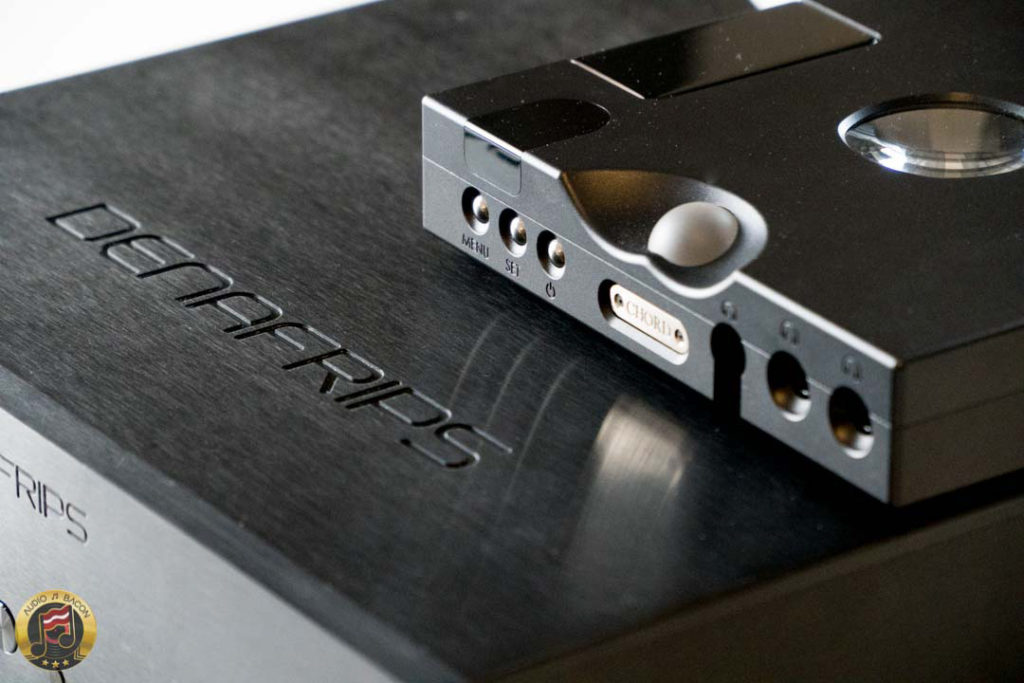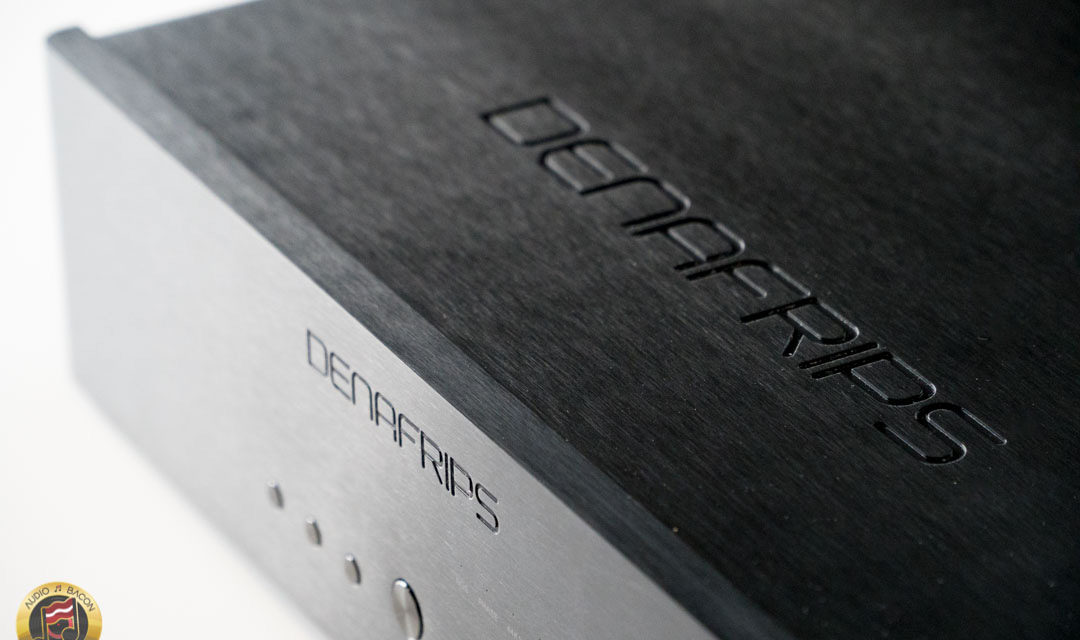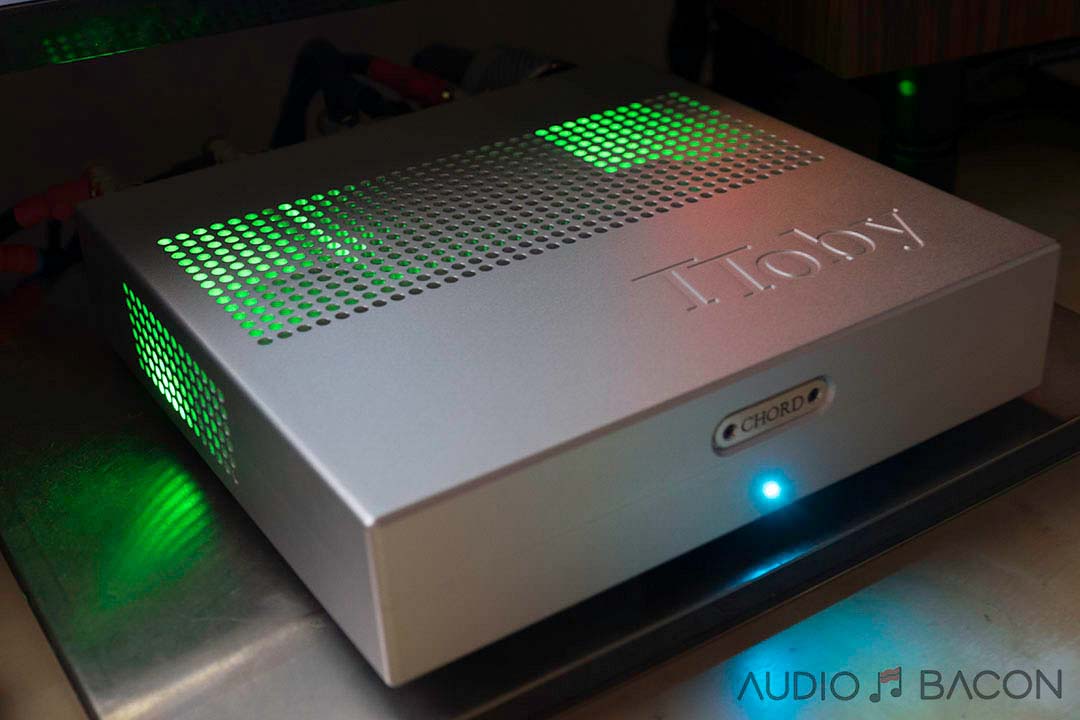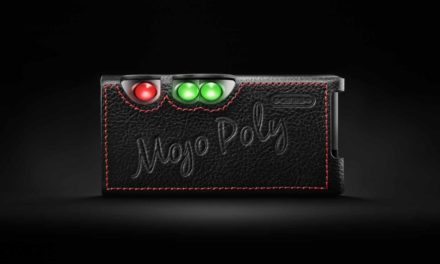Comparisons
Contents
Chord Electronics Qutest ($1,895)
It’s a bit comical to compare a 1.7-pound DAC to a 45-pound one. It kind of reminds me of those earlier MMA fights with no weight class. The Denafrips Terminator is also more than double the price of the Chord Electronics
First, the Terminator has a huge advantage in the power supply department. So in this comparison, I’ve powered the
These two DACs sound very different – and will appeal to different tastes. The Denafrips Terminator is more transparent, quieter, with a vastly wider soundstage. It has more canvas space with a finer tip brush. This allows it to paint a very spacious and tall image. There’s a dimensionality and physicality in the way it articulates reflective cues in a venue.

In addition, there’s effortless delineating and rounding out of edges into more solid, tangible shapes. The Denafrips Terminator simply uncovers the acoustic terrain in a very profound way. These technical qualities of the Denafrips Terminator will surely win over many audiophiles.
The Chord Electronics
The Chord Electronics
Essentially, if you’re a hardcore tone-snob, you may still prefer the
Chord Electronics Hugo TT 2 ($5,795)
The Hugo TT 2 has many of the traits of the
The Terminator still maintains a wider and taller soundstage and impeccable layering. It carries solidity and texture in a smooth fashion. And with magnificent speed. There’s just a lot going on spatially – filling up more of the air in front and around you.
With the Terminator, it feels like you’re sitting at the mixing board. It’s just cleaner, more exuberant, and “dreamy.”

On the other hand,
Bottomline: The Chord Electronics Hugo TT 2 is more soulful while the Denafrips Terminator is more outwardly insightful and expressive. The tonal character of the Hugo TT 2 is more of my preference. But others may weigh the pristine nature of the Terminator more.
Chord Electronics DAVE ($13,000)
Interestingly, I’ve received many emails requesting a comparison between these two DACs. So I’ll spend a little more time here.
The Denafrips Terminator excels at a more expansive sound field, crispy transient definition, and musical layering. It imparts a larger atmosphere around the room and never sounds confused (seeing a theme here?). It also has slightly more solidity in the mids. This is most likely due to the better power supply. I say this because I’ve actually heard a DAVE that exhibited these qualities with a bespoke linear power supply.
I mean, given the big differences in footprints, something had to give right? Interestingly enough, the DAVE does have a slightly darker background. It’s calmer and quieter in nature.
As mentioned earlier, the Terminator has a layer of beautification and a “dreamy” glaze. While the Chord Electronics DAVE has a much rawer application of tone. There’s no lipstick or mascara here. That is to say, the Terminator is cleaner and smoother whereas the DAVE is more even-handed in its level of excitement – with a focus on exhibiting more grit and textural variations. More “pop” if you will.
As with the aforementioned Chord Electronics DACs, the DAVE has a truer and more faithful tonal color – which means more realistic timbre. This is evident when a recording involves a multitude of instruemnts and voices. The DAVE provides the proper contrasts within the gradations. This helps to preserve the unique resonances of the instrument’s material and a singer’s vocal cords.
In addition, there’s a purity, naturalistic resolution, focus, and coherence that makes the DAVE more believable. Which in turns makes it more emotionally involving to my ears. The Denafrips Terminator, however, does sound clearer and presents the tiniest pieces of information (like individual strings and percussive strikes) in a more “outlined” fashion.










Fantastic review, great descriptions.
I try! Thank you, Craig.
I’m not even in the market for another DAC but your review just kept me reading. Much like you describe the delicate line toed by the Denafrips between detail and fullness, your use of engaging language whilst still conveying the technicalities is a rare combination. This is the gold standard for reviews.
Thank you for your kind words! Describing sound is difficult – but I find if you write as you listen (not after the clip ends), it’s more authentic and easier to articulate.
Great review Jay. Thanks! I’ve got a couple of questions. In your comparisons with the Chord Dave (or TT), it wasn’t clear to me always when the M Scaler was used or not. I’ve found the M Scaler to make a big difference for me. Do you use the full (2 SPDIF cable, 7xxKHz upscale) 1M taps mode or just one cable at less than full upscale capacity when used with the Chord Dave? I note that the Denafrips cannot handle a 7xxKHz input signal at all. I ask this as I find a big difference with my setup (Chord Dave, M Scaler, PS Audio Perfect Wave power center and AC12 power cord, Focal Utopias with special silver cable from Norne audio) with and without full M Scaler use. In any case this Denafrips sounds like a great DAC I may want for other systems I have. On another related note, here’s a belated thanks to you for your Boomslang (and other SPDIF cables) review (I did more testing of the Boomslangs for Jonny and also could not get them to work in my Dave/MScaler system either regardless what I tried – lots of things). But I ended up with some Black Cat Tron SPDIF BNC cables (best I’ve ever heard yet). Wow! If you can get those for review you might enjoy the experience. The folks at the Cable Co don’t have those to lend because no one ever returns them once they hear them!
As an upscaling aside, here’s a great and not very commonly seen article on how almost no product (except Chord, although they’re of course biased) is likely doing realtime upscaling correctly – as per Shannon’s sampling theory https://chordelectronics.co.uk/wp-content/uploads/2018/07/The-theory-behind-M-Scaler-technology.pdf. Chord is doing it right (to 16 bit resolution) with the M Scaler – So it’s not surprising that NOS sounds in many ways better on many DACs.
So again, many thanks for all you do – I really appreciate the information and style of your reviews!
To be fair, I was using a straight USB input for all DACs (from the Innuos server). I only used the M Scaler to test optical and coaxial performance (USB was SO much better with the Denafrips). I’ve written quite a few notes about the M Scaler in the process (for an upcoming review) – one being that even in passthrough mode, the M Scaler made all the Chord DACs sound significantly better (tonality, resolution, body, everything). It also seems like the “blue” mode strikes a tonal balance that works for me (less than a million taps). The HMS changes the game.
I did have a few hiccups with the Boomslangs in dual BNC mode but I did this weird thing where I plugged one into the S/PDIF first, played some music and changed some M scaler modes, then swapped it into the BNC #2, and haven’t had hiccups since. Unfortunately, I don’t know what the exact steps were. I’ve unplugged and replugged them and they seem to be working fine – zero dropouts for months. Really odd. I’ll have to give the Black Cat Tron a listen. I actually requested a cable for the review but they said they weren’t interested at the time. I would highly recommend a listen to the WAVE High Fidelity STREAM cables if you get the chance.
FWIW, the OS mode on the Terminator is better than having Roon do it – but that’s not much of a surprise I guess. You’re paying for the hardware.
The M Scaler is indeed a beast! I’ve found the same – that even in bypass mode (no upsampling) but with dual SPDIF to the Dave, things sound better than straight into the Dave via USB. Interesting about the Boomslangs. I tried lots of dual cable connections (the only way I want to use it) and could never get anything to work beyond ~192KHz rate. As to other SPDIF cables, they do seem to make quite a difference!
Thanks Jay for this nice review. I understand there is an upgrade coming this year for the DSD module…
It would have ben interesting to compare a) USB input with the Amanero module inside versus b) using a good quality DDC like singxer SU1 or SU6 (that one has same clocks than terminator) AND the I2S HDMI connection (advantage: separation of data and clock signals + no extra conversion needed). Aren’t you curious?
One question: if you use an appropriate power cord like the furutech one you have + black magic USB cable on terminator, how does it compare then with the more tonaly satisfyings DACs you tested? Can you get the best of both worlds?
A friend owns the Chord Blu Mk2 and Terminator. And we have compared the various upsampling modes from Blu Mk2 (it has a switch at the back to select upsampling levels) into the Terminator playing CDs. Speakers are Vivid Kaya 45, amp is Esoteric F-03A (class A 30 watts)
Each time we switched to a higher level, the spatial cues, and accuracy of the sound/tone goes up, and instruments and imaging becomes more “real” & holographic and better tone. The difference between ‘medium’ and ‘high’ upsampling is surprising significant.
Blu Mk2 in “Upsampling High” mode into Terminator NOS mode (through BNC cable) is a force to be reckoned with. You kinda get the best of both worlds from Chord and Terminator.
I was rather surprised you didn’t find the M-Scaler with Terminator NOS to be a great combo.
I completely agree with you – your impressions are spot on. I think NOS with M Scaler is a great combo – and many will prefer the M Scaler at its maximum upsampling mode. That thing just works miracles. However, in my setup, I believe that coaxial input robs some of the intrinsic soul of the recording (I listen to mostly vocals). It comes off a little anemic, even in passthrough mode. At that point, the M Scaler does its job, but that warmth is forever gone. My ears tell me that the coaxial input is holding it back. It has been a while so I’ll give it another listen and update if needed. Thank you for your comments.
“Unfortunately, I could not test the I2S input”
IMO this is very unfortunate and impacts veracity of the review in total since it is said that I2S is the preferred input on this DAC. Would add much value if you can compare it to the rest of your findings.
Due to heavy interest, Mike’s sending me an I2S adapter. I’ll update the review with my findings.
Thanks for the detailed review. I am toying with upgrading my current DAC. My question is this: How did the Denafrips rate comparatively with regard to timbrel accuracy? Or to put it another way: If you played a solo cello – which dac sounds closest to a real cello? (Actually any acoustic instrument but strings have the most complex waveform and are the hardest to recreate. )
Thanks again for the thoughtful review Jay.
Great question. Accurate timbre involves a few traits – including resolution, tone, timing, weight, etc. The Denafrips excels in the resolution portion, and perhaps timing. But the rest of the DACs here do better with color and weight. Tuning with power cords and USB cables does help the Terminator’s case a bit. The Chord Electronics TT 2 and DAVE have enough of these traits to be the most accurate I’ve heard so far – especially with a Hugo M Scaler. Digital has never more real.
That’s really insightful. Thanks for detailing the character of DT and comparing with other DACs is really helpful. This review came in right time as I am undecided between Denafrips vs Hugo TT2. I do not have chance to audition Denafrips, but I will get chance to review TT2 soon. I did consider Mytek Brooklyn DAC+ as it really great DAC which one of my friend has. It’s very musical, dynamic, mids are thick and has muscle. Later I heard about Denafrips, since I couldn’t get chance to audition this, I am now waiting to audition TT2. From review it looks like Denafrips has sound stage, dynamic and immersive sound. I give preference to musicality over clarity or naturalness. Hence, it would be great help if you can share your thoughts on musicality. Which one is more musical of both. Thanks, Soma
Thanks Jay for this nice review. I understand there is an upgrade coming this year for the DSD module…
It would have ben interesting to compare a) USB input with the Amanero module inside versus b) using a good quality DDC like singxer SU1 or SU6 (that one has same clocks than terminator) AND the I2S HDMI connection (advantage: separation of data and clock signals + no extra conversion needed). Aren’t you curious?
One question: if you use an appropriate power cord like the furutech one you have + black magic USB cable on terminator, how does it compare then with the more tonaly satisfyings DACs you tested? Can you get the best of both worlds?
Mike will be sending me a USB to I2S converter this week. I’ll update the review with my findings.
These power cords and USB cables, IMO, give it a better tonal balance but trades resolution, stereo imaging, focus, and spatial clarity. This is an expected tradeoff and some will be completely happy with that. Many are just fine with the Terminator sound out of the box. The only way to know is to hear it for yourself (many of these cable companies offer 30 day trials).
The beauty of the Denafrips Terminator is its ability to provide incredible insight into a recording with “lifelike resolution.”
The Iconoclast OFE speaker cables bring the Terminator closer in tone to the other DACs. Still less warm but, to my ears, more natural sounding. It does exchange focus and air though.
Hey Jay, mind telling us the difference between the Dave & the PS Directstream?
In your comparison, you made it clear the Dave & the DS were more tonally warmer tonally than the Terminator, but how do they compare against each other in those aspects?
Your review made it seem like they share a similar sound signature, but the Dave is nearly 3 times the price.
The DAVE has much more resolution, more lifelike articulation, super analog, quieter, and has more accurate timbre. The DAVE’s biggest advantage is timing. You’re able to hear reflective and ambient cues more naturally – and transients have a tangibility to them. In short, it just sounds more real. To my ears, it’s the perfect “digital foundation” to build a digital playback system on. But yeah, it’s much pricier.
That said, the DSD is definitely warmer and denser sounding than the DAVE. A very musical sounding DAC regardless.
Great review which helped me in my decision to order the 2020 version Terminator, thank you. I have to say my experience of the service provided by Alvin at Vinshine has been exceptional, I wonder if he ever sleeps.
I’m really interested to compare the Terminator against my current Yggdrasil A2. What puzzles me is, I had a home loan of the DAVE, which was clearly better than the Bluesound Vault 2 integral DAC, but I could not discern any difference whatsoever between DAVE and the integral DAC in my Mcintosh C2500 pre. I even spoke with Chord, who were very helpful, to ensure I’d got it set up correctly, to no avail. The Yggdrasil however was the straw that broke my vinyl systems back and sent me fully digital. Present day, with Auralic Aries G2, Mutec, another company with excellent service, MC3 + and REF10, Levinson 523 pre & 33H/Audio Music AM833S amps, with Focal Maestro Utopia/Quad 2905 speakers, I’m hoping the 2020 vision Terminator can really shine and maybe get another loan of DAVE and see if my view of it has changed.
Great Review Jay. As a current happy owner of Terminator I concur with your findings. When listening to it I find myself much more apprecating dynamics and information of music (thus the movement and action of musicians ) rather than the timbre of different instruments. It’s also a musical dac but musical in an very differnet way compared to a Dave or a DCS. I suspect the tonality issue ( a little bit rounded in midrange and not as differentiating as other great dacs) is due to its isolation foot and unique output stage (not tube, not opamp), but who can tell:) It’s still a great value
Thank you for your kind words. I think you’ve pointed out the trade-offs quite accurately – and it’s aligned to what I hear. In any case, definitely great bang for your buck.
Hi Jay, please try to get the new terminator DSP then re-evaluate. I just recieved mine. Its a major change for the better!
Best Terminator review around, well done!
Question: what are the plus & cons of the 2 USB drivers available on the terminator (Amanero vs Combo 384Asio)? I am streaming from Qobuz sublime and find the Amanero more expressive… input welcome!
I no longer have the review unit, perhaps someone else could chime in?
May be time for an actualisation of your review: Denafrips issued a new DSD board affecting the USB input (no longer amanero) with very good results apparently (a thread on audiophyle style).
BTW I lstened finally toI2S input on my terminator using su6 DDC and audioquest platinum: I lost musicality even if sound looks better technically… I think that may be caused by the active isolation in SU6. I did ot liked either this feature in ISORegen and had to defeat it. I think SOTM boss doesn(t like active isolation neither (goes passive).
An excellent review, Jay!
On the issue of I2S connectivity between digital source and DAC – it works well on shorter (and suitably high-quality HDMI cables). Technically, for high-end audio, any cable longer than 10 cm (~4″) is gradually and subtly degrading (affecting musicality) the digital audio signal. If in doubt, consult relevant I2S/HDMI eng. standard. HDMI was created primarily for video signal transmission and the idea of adopting it to separate the audio signal is a good one, in principle, but the quality of implementation (as usually in high-end audio) does matter.
Fantastic review. Really clear and authoritative writing style. Wish I could afford a Terminator!!
Jay the work and effort you put into your reviews are very much appreciated and Thank You for that .
I had the Denafrips Terminator for a number of months before most of the online chat exploded over the internet. I bought it out of pure curiosity early 2017 . initially I liked it very much however as time went on I ultimately became very disappointed with it especially with vocals and speaking voices of great recordings that much , much more expensive digital front ends offer. Though out of my price range wanting a digital front end that reproduced a sense of realism with vocals and speaking human voices is one of my top priorities and getting that in my price range of $5,000.00 for a dac I finally found it with a dac that sells for under $4,000.00 USD made by Rockna’s sister company AudioByte.
I found the AudioByte Hydra Vox dac to satisfy my tastes outperforming the Denafrips Terminator .
I agree with you regarding your impressions of speaking voices. It’s one of the reasons why I’ve been listening to the Chord Hugo TT 2 more than the DAVE these days. The AudioByte Hydra Vox sounds like it’s up my alley… 🙂 Thank you for the recommendation – I’ll definitely try to get a unit in for review.
Hi Jeffery,
I am shopping for the best DAC my pandemic budget currently allows (say up to ~5,000 USD). I am just swinging between Terminator, Holo MAY and Rockna. It is impossible to compare them side by side now or to find anybody’s opinion on all of them. However, since 2017, Denafrips released Terminator II, supposedly a step up from the original. Holo Audio MAY Kitsune became Product of the Year 2020 and Rockna has now Rockna WaveLight and even better WaveDream models, supposedly superior to their smaller sister Hydra Vox.
Can you update us on that competition if you still following recent developments in renewed interests in the older (than delta-Sigma) R2R topology implemented in the newest DACs? Thanks.
Thank you for the review, Jay.
A comparison with the Chord Mojo would have been even more comical than with the Qutest, yet interesting. I have a Mojo driving my main system and I can never get myself to forget these words from 6moons review (https://6moons.com/audioreviews2/chord2/4.html) – “Hey, how about this for a great afternoon of audiophile shenanigans? Grab a nice gut-less bit full-sized DAC chassis, a nice exit-looking one. Stick the Mojo in it. Feed your system with it. Fool your mates into thinking playback is via a $5K DAC. You’ll get away with it and they’ll be singing praises. Then, later, they’ll string you up.”.
As I am thinking about purchasing a proper $5K DAC, it would have been interesting to understand exactly what one would get for the money over the Mojo. Thank you again.
Have you compared the Terminator with the PLUS terminator. Is the PLUS worth it. Is it more musical, more analog?
Thank you.